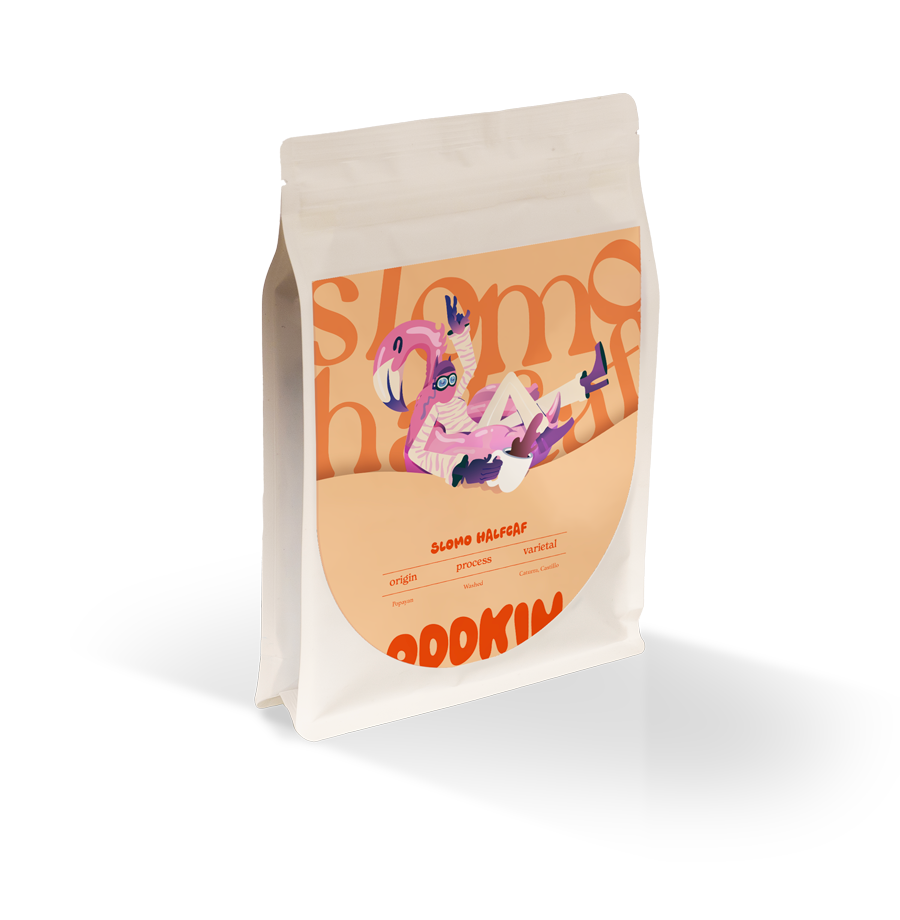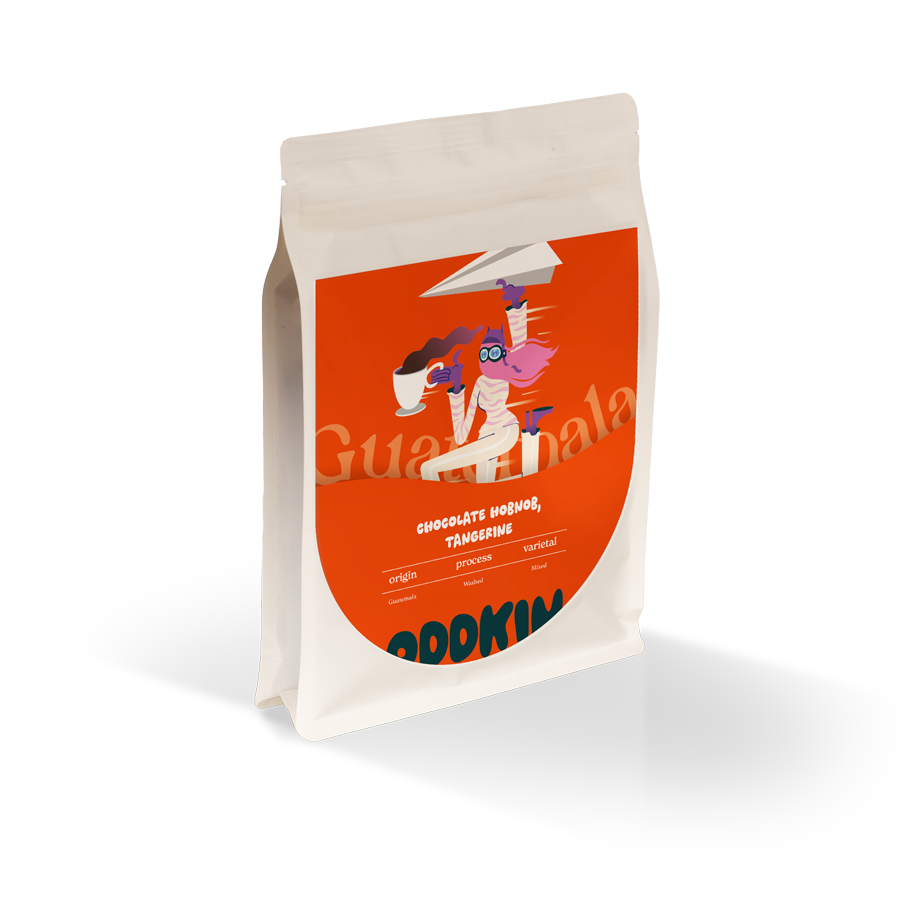How Is Decaf Coffee Made?
If you’re a big fan of decaf beans - this guide is for you! Discover different decaffeination processes to better understand how coffee is decaffeinated to give you that almost caffeine-free kick.
Did you know? At Odd Kin we offer natural decafs, as we believe this to be the best way to decaffeinate coffee for both taste and environmental factors!
Explore:
- What is decaf?
- How is caffeine removed from coffee?
- How is decaf processed?
- What solvents are used?
- Is methylene chloride decaffeination safe?
- Types of decaf processes:
- Indirect-solvent Process
- Direct-solvent Process
- Swiss Water Process
- Carbon Dioxide Process
- Sugarcane E.A. Decaf Process
- What is the healthiest decaf process?
- Rethinking decaf
What is decaffeinated coffee?
Decaffeinated coffee, commonly shortened to decaf, is a type of coffee that has had a large amount of its caffeine removed during the processing stage. While decaf coffees are not completely caffeine-free, they undergo processes that remove between 97 - 99.9% of the caffeine content within the bean.
How is caffeine removed from coffee?
All coffee beans start their journey from bean to cup in the same way: as coffee cherries that are grown and picked when ripe. The difference between regular coffee and decaf lies is the type of coffee processing method used. Decaffeination processes are designed to extract the caffeine from the bean using specific agents.

How is decaf coffee processed?
To make decaf coffee, coffee beans must undergo a specific process designed to remove the majority of the caffeine content that naturally exists within the bean. Decaf coffee processing methods involve water and/or chemical solvents being applied directly or indirectly for extraction.
Once this process is complete, the decaffeinated beans are washed and steamed before being roasted by speciality coffee roasters like us.
What solvents are used to decaffeinate coffee?
The two types of solvents used to decaffeinate coffee are methylene chloride (CH₂Cl₂), and ethyl acetate (C₄H₈O₂). Natural decaffeination typically involves the use of ethyl acetate, because unlike methylene chloride, ethyl acetate can be produced from natural sources that are chemical free.
Is methylene chloride decaffeination safe?
The U.S. Food and Drug Administration (FDA) states that methylene chloride can safely be used for decaffeination, but residual methylene chloride traces must stay under ten parts per million.
While methylene chloride is not considered to pose a health risk, many decaf coffee drinkers feel more comfortable with processes that use natural solvents as decaffeination agents.
It all comes down to personal preference really! At our roastery we prefer to roast naturally decaffeinated washed coffees using the Sugarcane E.A. method, explained here.
5 types of decaffeination processes explained:
There are a few different ways to remove caffeine from coffee. The most common decaffeination processes can be categorised into solvent and non-solvent processes, extracted through direct or indirect exposure.
Indirect-solvent Process:
With indirect-solvent decaffeination, the solvent used never comes into direct contact with the coffee beans.
First, the beans are soaked for several hours in water kept just below boiling point. The temperature helps to remove all water-soluble components of the beans, including caffeine, oils and flavour elements.
After this, the beans are removed from the water (which is now rich in caffeine and flavour) and the ethyl acetate or methylene chloride is added. This stage of the process sees the chemical solvent bond with the caffeine molecules.
Once bonded, the mixture is skimmed from the surface of the water solution, removing traces of both the solvent and caffeine. The beans are then resubmerged in the initial water tank to reabsorb the coffee oils and flavours that were extracted in stage one.
Indirect solvent methods have been around since 1941, and since then, coffee producers have worked to transform this process using natural, organic solvents.
Direct-solvent Process:
The direct-solvent decaffeination process is one of the oldest methods used to remove caffeine from coffee, dating all the way back to 1903.
A merchant called Ludwig Roselius has been credited with the invention and development of this process. It's believed he discovered the opportunity by chance when his freight of coffee got soaked in sea water.
Not wanting to waste his goods, he tried the beans and discovered that although the caffeine had been removed, the flavour still existed.
Originally, a solvent called benzene (C6H6) was used for extraction. However, benzene (now known as carcinogen), was later found to pose significant health risks, and the process was replaced with methylene chloride and ethyl acetate.
The direct method begins by steaming the coffee beans to open their pores. Once opened, the beans become more receptive to the addition of solvents, and are ready to be rinsed with either methylene chloride or ethyl acetate.
The removal of caffeine is achieved through repeated solvent rinsing over a ten hour period. After this, the beans are steamed for a second time to remove residual solvent traces through evaporation.
Swiss Water Process:
Unlike the previous decaffeination processes mentioned, the Swiss Water process is free from solvents and only uses water to decaffeinate the beans. Despite being developed back in 1933, this process only became commercialised in 1980.
To achieve this method, green coffee extract (GCE) is needed. GCE is essentially a solution that contains all water-soluble components found in green coffee beans, minus the caffeine.
This solution is made by soaking the beans in hot water (which extracts the caffeine and flavour oils into the water). The water is then filtered through an activated charcoal filter, which works to strain through the coffee's oils and flavours while removing the caffeine molecules.
Once the GCE solution is ready, a fresh batch of caffeinated coffee beans are added. The gradient pressure within the solution results in the caffeine molecules migrating from the fresh batch into the GCE.
All other water-soluble coffee components (which are where the flavours lie) are retained within the new coffee - which means the GCE solution itself is the source of the next batch’s caffeine content removal.
The same process is repeated over a period of ten hours to meet the target level of decaffeination.
Carbon Dioxide Process:
The Carbon Dioxide decaffeination process uses compressed carbon dioxide (CO2) to extract the caffeine from the bean. Developed by scientist Kurt Zosel, this method requires high pressure vessels to turn carbon dioxide into a supercritical fluid that the caffeine can then dissolve into.
To make this type of decaf coffee, the beans are first soaked in water. They then get transferred into an extraction vessel made of stainless steel. Once the vessel has been sealed, the beans are exposed to water and carbon dioxide.
The mixture is circulated through the vessel at a temperature and pressure that's high enough to create a supercritical fluid. This fluid works to dissolve the beans' caffeine. Because coffee bean compounds are insoluble to (CO2), the flavour of the coffee remains.
The fluid then gets transferred into a separate vessel where the pressure is released and the (CO2) returns to its previous state, leaving the caffeine behind.
The carbon dioxide then gets recirculated into the extraction vessel, and can be used for decaffeinate multiple batches. This makes it a relatively cost-effective process, more commonly used by commercial coffee companies than speciality roasters.
Sugarcane E.A. Decaf Process:
Originating in Colombia, the sugarcane decaf process uses fermented sugarcane to produce natural ethyl acetate. When mixed with water, the ethyl acetate creates a solution that can be used to remove the caffeine molecules from the beans.
If you've ever tasted sugarcane, you'll be able to vouch for the fact it's super sweet. This makes it the ideal source for naturally sweetened coffees like Popayán - our latest batch of Colombian decaf coffee beans.
So how does it work? To help you understand, we've broken down the decaf coffee sugarcane process step by step:
Step 1: The coffee is fully washed and prepped for caffeine extraction via steaming. To open the beans’ pores and increase the porosity of the coffee, the beans are steamed for around thirty minutes.
Step 2: After being steamed, the beans are submerged into a tank that contains the fermented sugarcane ethyl acetate solution. The chemical element within this solvent bonds to the beans, helping to draw out and dissolve the caffeine.
Step 3: This process is repeated for roughly ten hours until the beans reach the required level of decaffeination. Each time the beans reach a certain level of saturation, the tank is refilled with a fresh solution.
Step 4: After being decaffeinated, the beans are then resteamed to ensure the core of the beans are thoroughly cleaned and free from traces of the natural sugarcane ethyl acetate.
Step 5: The drying process begins and the beans are dried until they reach their previous level of moisture.
The benefits of sugarcane decaf coffee:
Decaf coffee made through the sugarcane process offers several benefits to everyone involved in the supply chain. There are so many reasons why we believe it to be one of the best decaf processes out there - a few of the key benefits include:
- Uses natural sources: It's a natural, green and clean way to decaffeinate coffee and maintain flavour.
- Supports local coffee producers: No matter where coffee comes from, when beans are both grown and decaffeinated at origin, local producers are able to earn higher wages.
- Sustainably processed: In addition to increasing farmers earnings, decaffeinating at origin also minimises supply chain shipments and decreases the carbon footprint.
- Avoids high levels of heat and pressure: With less pressure and heat applied to the beans, their cellular structure stays intact.
What coffee is decaffeinated without chemicals?
When you see that coffee has been decaffeinated using the Sugarcane E.A. Process, you can be certain that the coffee you're drinking is chemical-free. To keep things as natural as possible, we only source coffee that has been processed naturally at plants that use the sugarcane process.
Located in south western regions of Colombia, these plants use locally grown sugarcane and volcanic water from the slopes of Volcán Nevado del Ruiz and Puracé, Meseta de Popayán.

Photo Credit: Volcán Nevado Del Ruiz by Edwin Gabriel Rubio Cortes (Canva).
What is the healthiest process for decaf?
The Swiss Water method is recognised as one of the healthiest ways to decaffeinate coffee. However, sugarcane decaf is making waves as an equally healthy, natural process that is able to offer additional benefits.
Sugarcane decaf vs. Swiss Water
There’s no denying the fact that both the Sugarcane and Swiss Water processes are able to create flavourful decaf coffee that’s natural, safe and chemical-free. The main difference between the two is the amount of caffeine removed, which is 97% for sugarcane, and closer to 99.9% for Swiss Water.
Despite offering a slightly lower caffeine content, a downside of the Swiss Water Process is that it has been patented by a Canadian company called Swiss Water®, so any beans grown at origin must be transported to their facility in Canada for decaffeination.
Rethinking decaf
For several years, certain stigmas attached to decaffeination have resulted in decaf coffees largely being put on the back burner.
Perceived to be high in chemicals and low in taste, many coffee drinkers know little about the wonderful world of decaf and all it has to offer.
We want to change that.
We're in the process of expanding our decaf coffee offering with fresh roasts that offer the same taste and quality you caffeine-lovers are used to.
Decaf coffee, it's your time to shine. ✨
Watch this space.
















